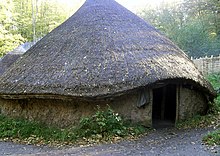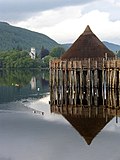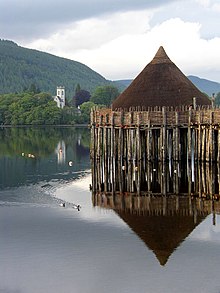Roundhouse (dwelling)
This article needs additional citations for verification. (October 2011) |
A roundhouse is a type of house with a circular plan, usually with a conical roof. In the later part of the 20th century, modern designs of roundhouse eco-buildings were constructed[where?] with materials such as cob, cordwood or straw bale walls and reciprocal frame green roofs.
Europe[]
United Kingdom[]

Roundhouses were the standard form of housing built in Britain from the Bronze Age throughout the Iron Age, and in some areas well into the Sub Roman period. The people built walls made of either stone or of wooden posts joined by wattle-and-daub panels, and topped with a conical thatched roof. These ranged in size from less than 5m in diameter to over 15m. The Atlantic roundhouse, Broch, and Wheelhouse styles were used in Scotland. The remains of many Bronze Age roundhouses can still be found scattered across open heathland, such as Dartmoor, as stone 'hut circles'.
Early archeologists determined what they believed were the characteristics of such structures by the layout of the postholes, although a few timbers were found preserved in bogs. The rest has been postulated by experimental archaeology, which has tried different techniques to demonstrate the most likely form and function of the buildings. For example, experiments have shown that a conical roof with a pitch of about 45 degrees would have been the strongest and most efficient design.
Peter J. Reynolds also demonstrated that, although a central fire would have been lit inside for heating and cooking, there could not have been a smoke hole in the apex of the roof, for this would have caused an updraft that would have rapidly set fire to the thatch. Instead, smoke would have been allowed to accumulate harmlessly inside the roof space, and slowly leak out through the thatch.[1]
Many modern simulations of roundhouses have been built, including:
| Image | Name | Town | County | Country | Notes |
|---|---|---|---|---|---|

|
Barbury Castle | Swindon | Wiltshire | England | (destroyed by fire) |
| Beeston Bronze Age Roundhouse | Beeston Castle | Cheshire | England | Built 2019 | |

|
Bodrifty Iron Age Settlement | Cornwall | England | ||
| Brigantium Archeological Centre | High Rochester | Northumberland | England | Now Dismantled | |

|
Butser Ancient Farm | Hampshire | England | ||

|
Cae Mabon | Wales | |||

|
Castell Henllys | Pembrokeshire | Wales | ||
| Cockley Cley, | near Swaffham | Norfolk | England | ||

|
Flag Fen | near Peterborough | England | ||
| Mellor roundhouse reconstruction | Greater Manchester | England | |||

|
Peat Moors Centre | Somerset | England | Closed to the public 31 October 2008 | |

|
Raincliffe Woods | Scarborough | North Yorkshire | England | Roof destroyed by fire April 2013. Timbers and thatch removed by Scarborough Conservation Volunteers. Walls undamaged. |

|
Ryedale Folk Museum | near Pickering | North Yorkshire | England | |

|
St. Fagans museum, Wales. | South Glamorgan | Wales | The museum exhibition open for 20 years and was based on roundhouses in Conderton, Worcestershire.[2] | |

|
St Fagans National History Museum | South Glamorgan | Wales | New exhibition opened in 2016.[3] | |

|
Scottish Crannog Centre | Loch Tay | Perthshire | Scotland | Roundhouse reconstruction on a man made island |
| Stonehenge Visitor Centre roundhouses | Wiltshire | England | |||
| Tatton Iron Age roundhouse and pit | Cheshire | England |
Must Farm revelations[]
Much of the earlier supposition was confirmed or denied at a stroke by the finding of a set of Bronze Age roundhouses at the archaeological dig at Must Farm in Cambridgeshire, UK, where samples of all the materials, from posts to walls, to roof were all found, collapsed and charred, but still in situ after 3 000 years.
Modern British roundhouses[]

That Roundhouse is an early example of a modern roundhouse dwelling which was built in Pembrokeshire Coast National Park, Wales without planning permission as part of the Brithdir Mawr village which was discovered by the authorities in 1998.[4] It is constructed from a wooden frame of hand-cut Douglas Fir forest thinnings with cordwood infill, and reciprocal frame turf roof based on permaculture principles mainly from local natural resources. It was subject to a lengthy planning battle including a court injunction to force its demolition before finally receiving planning approval for 3 years in September 2008.[5]
Ireland[]
Irish crannógs are located in Craggaunowen, Ireland; the Irish National Heritage Park, in Wexford, Ireland
Italy[]
Trulli (singular: trullo) are houses with conical roofs, and sometimes circular walls, found in parts of the southern Italian region of Apulia.
Spain[]
Galicia – Asturias[]
Pallozas[]

A palloza is a traditional thatched house as found in Leonese county of El Bierzo, Serra dos Ancares in Galicia, and south-west of Asturias; corresponding to Astur tribes area, one of pre Hispano-Celtic inhabitants of northwest Hispania. It is circular or oval, and about ten or twenty metres in diameter and is built to withstand severe winter weather at a typical altitude of 1,200 metres.
The main structure is stone, and is divided internally into separate areas for the family and their animals, with separate entrances. The roof is conical, made from rye straw on a wooden frame. There is no chimney, the smoke from the kitchen fire seeps out through the thatch.
As well as living space for humans and animals, a palloza has its own bread oven, workshops for wood, metal and leather work, and a loom. Only the eldest couple of an extended family had their own bedroom, which they shared with the youngest children. The rest of the family slept in the hay loft, in the roof space.
Castros[]
North America[]
Roundhouses were a common form of architecture in some Native American Tribes. Traditional roundhouses were often used for ceremonies "and provided a large work area during inclement weather."[6] The Chaw Se' Roundhouse in California's Indian Grinding Rock State Historic Park is designated with state historical marker #1001.[7]
Modern roundhouses are being built such as the one at Dancing Rabbit Ecovillage near Rutledge, Missouri, built of cob.[8]
Oceania[]
Raun Haus, Papua New Guinea[]
Roundhouses are still in use in Papua New Guinea and are very similar to the ones built in western Europe.[9]
References[]
- ^ Aston, Mick (2001-10-05). "Peter Reynolds: archaeologist who showed us what the Iron Age was really like (obituary) In Africa a round house was found on a volcano". The Guardian. London.
- ^ "The Project: St Fagans 05". theroundhouse.org. 2005.
- ^ "Starting work on our new Celtic Village". amgueddfa.cymru. 20 December 2013.
- ^ "Secret village to be pulled down". BBC News. 1998-10-23. Retrieved 2009-04-12.
- ^ Barkham, Patrick (2009-04-12). "Round the houses". The Guardian. London. Retrieved 2009-04-12.
- ^ Roseville History before 1820, Roseville Historical Society
- ^ Chaw Se' Roundhouse (No. 1001 California Historical Marker)
- ^ "Cob roundhouse". Archived from the original on 2009-04-10.
- ^ "Raun Haus / Round Haus".
External links[]
| Wikimedia Commons has media related to Round houses. |
- House types
- Round buildings
- Archaeology of structures
- European archaeology
- Sustainable building


